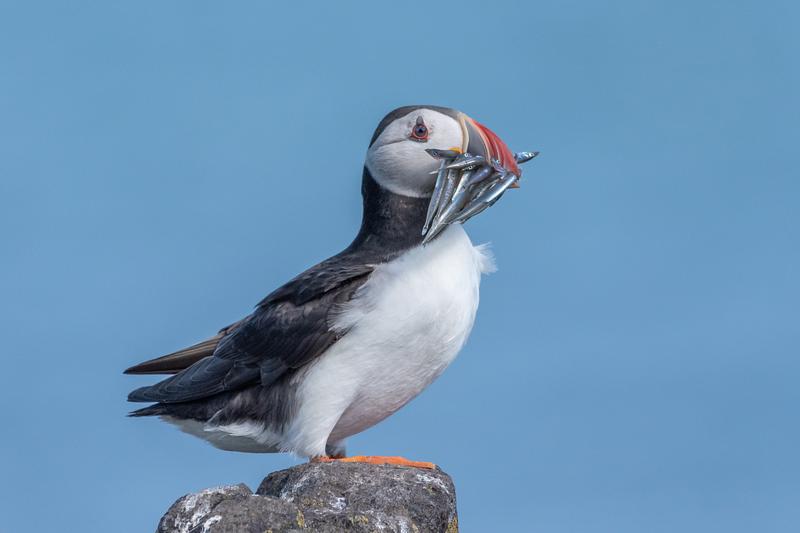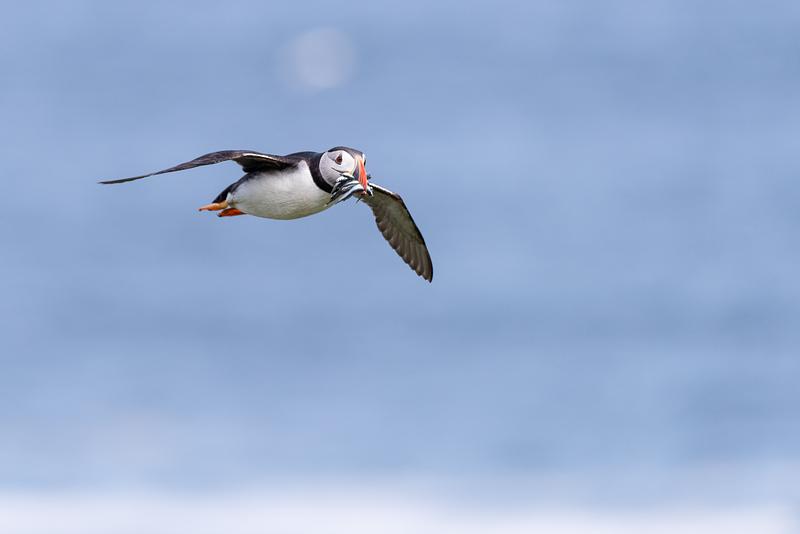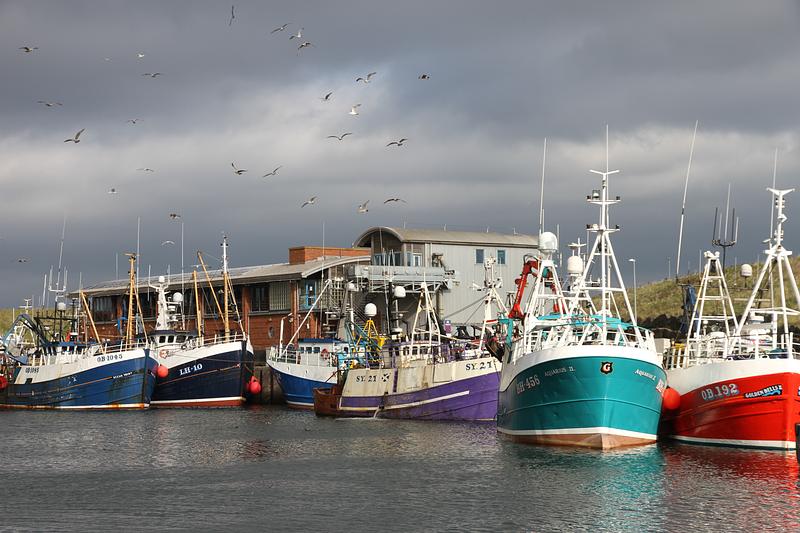_Emma_Marriott.jpg)
What's so Great about Sandeels?
By Emma Marriott, Conservation Assistant
Have you ever seen a sandeel? Your initial instinct might be no — but if you’re familiar with Atlantic puffins (Fratercula arctica), then it’s highly likely that you have. After all, it’s one of their favourite food sources and you’ll often spot these shimmering silver fish in photographs, dangling from a puffin’s flamboyant bill.
But it’s not just puffins that enjoy feasting on them. Packed with protein and extremely nutritious, sandeels are preyed upon by a whole host of marine creatures including seabirds like black-legged kittiwakes (Rissa tridactyla) and terns (Sternidae), dolphins and porpoises, and economically important fish including pollack (Pollachius pollachius), Atlantic salmon (Salmo salar) and mackerel (Scombrus scombrus). These tiny fish even feed marine mammals as huge as humpback and minke whales, comprising as much as half of their diet!

This is particularly astonishing when you consider that sandeels (of which we have 5 species in Scotland) weigh between 15 and 40 grams (that’s lighter than a chicken’s egg) and that the smallest species (the Lesser Sandeel (Ammodytes tobianus)) only grows to a length of 20 centimetres at most.
_Emma_Marriott.jpg)
It’s no wonder that those that feed on them must eat a lot; which also means that sandeels have had to evolve to be rather prolific breeders. The females will each lay up to 15,000 eggs or more, which will hatch within a few weeks. For the next 10 years or so of their lives, if they’re lucky enough not to be eaten, they will reside in the sand and rarely stray far from their burrows to feed on the plankton that float by on the current. They must feed well during the summer, as these fish will hibernate over winter, burying themselves beneath the sediment on the seabed where they will remain and emerge only to spawn in December and January.
Just to confuse you, it’s worthwhile mentioning that sandeels are not eels at all. They do, however, live in the sand into which they will bury themselves for protection against predators—of which, you’ll now agree, they have quite a few!
_Ron_MacDonald.jpg)
Marine animals are not the only ones who can’t get enough of these silver gems of the marine ecosystem. Every year, hundreds of thousands of tonnes of sandeels are harvested industrially by humans for their oil and as fishmeal, a product which used to be used extensively as fertiliser but which is now used predominantly as animal feed.
In combination with climate change, as a result of which our oceans are becoming warmer, and with the additional pressure of some destructive fishing practices such as bottom trawling, sandeel populations are declining. This is having a knock-on effect throughout the food chain. Foodwebs in the North Atlantic are said to have a "wasp-waist" structure (i.e. pinched in the middle) in which there is a relatively low diversity of fish in the middle of the food chain and a much higher diversity of species above and below it. In other words, there are lots of species higher up the food chain who rely on a much smaller number of species (which includes sandeels) for food; likewise, this small number of species relies on a much larger of proportion of species further down the food chain. As a result, any change in the abundance of 'mid-level' species like sandeels is likely to impact a great number of animals, from the disproportionately large variety of species that feed on them to the similarly extensive variety of species that they themselves feed on.
_Susam_Davies.jpg)
Many of these animals are already experiencing declines in their populations due to numerous pressures. In terms of seabirds, kittiwakes and puffins are especially dependent on sandeels. In the past 60 years black-legged kittiwake numbers have halved, partly due to this lack of their favoured foodstuff; and a study by the British Trust for Ornithology has predicted a potential dive in puffin numbers by up to 90% by 2050 should current situations regarding global warming and industrial fishing be left unchecked. Localised losses of sandeels can also result in the animals feeding on them to journey much further than before to forage. This increased energetic demand can impact survival rates, particularly during the breeding season when adults need to feed not only themselves but also their rapidly growing young.

Currently, there are measures in place to preserve sandeel stocks. Since 2000, a 20,000 km2 section of sea on Scotland’s east coast (which includes the Firth of Forth) has been closed to sandeel fishing and, since 2021, the UK has prohibited sandeel fishing by UK vessels in its waters in the North Sea.
However, even under these regulations, sandeel populations could still be fished in UK waters to a degree that would deplete them to an extent that would negatively impact marine animals. Plus, the majority of those vessels industrially fishing sandeels are from countries including Denmark, Norway and Germany, who are not affected by this closure.

This is why so many people are welcoming the Scottish Government’s consultation on proposals to close sandeel fishing in all of Scotland’s waters. As only one main vessel from the UK historically harvests sandeel here, this proposal would have a minimal impact on Scottish businesses. In fact, in the long term, it should benefit the Scottish fishing industry as a whole, helping to preserve the economically important fish stocks that feed on sandeels. It could also boost the UK economy and the coastal communities that rely on wildlife tourism, as nature will surely benefit. With marine wildlife under so many novel pressures, the majority of which we are at least partially responsible for, every little bit that we can do to ease these issues is a step closer to healthy and flourishing ecosystems for everyone to enjoy — now and in the future.
The consultation to close sandeel fishing in Scottish waters will close on October 13th, 2023, so if you feel as passionately as we do about preserving sandeels for all that rely upon them, we encourage you to show your support by responding to the consultation directly.
If you would like to read more about the consultation, we have a blog that goes into more detail on the subject.
To learn more about sandeels, visit NatureScot’s information page or the Wildlife Trusts’ species page.
To keep up to date with what’s happening at the Scottish Seabird Centre throughout the year, check out our regular blogs or follow us on Facebook or Twitter.
- Thumbnail © Nicol Nicholson
- Header © Emma Marriott

My role as Conservation Assistant has been funded by The National Lottery Heritage Fund via the New to Nature programme - an exciting initiative that is helping to support people from diverse backgrounds into environmental roles. To find out more, visit: www.groundwork.org.uk/new-to-nature-apply
